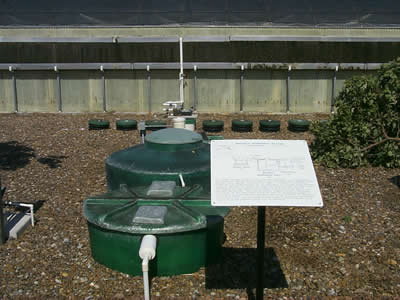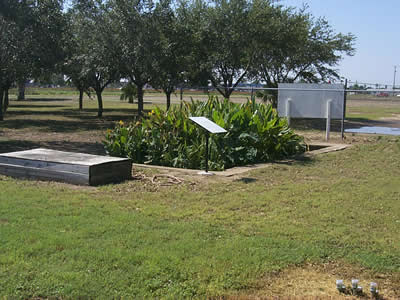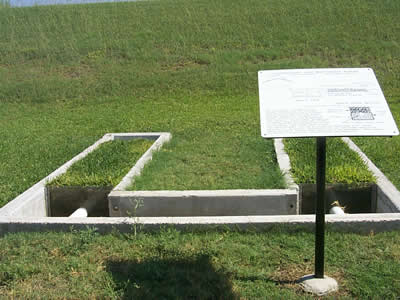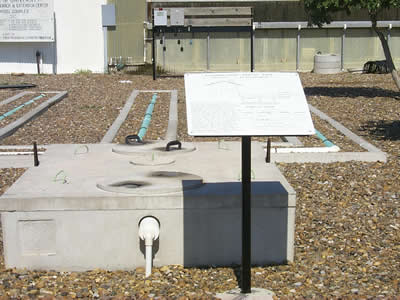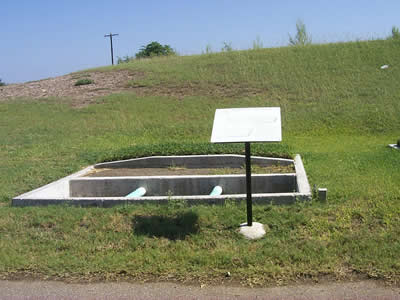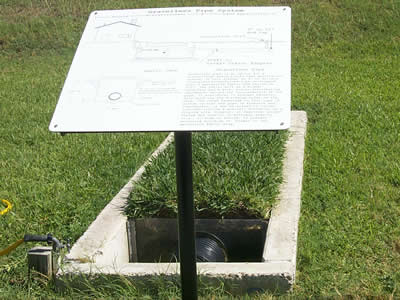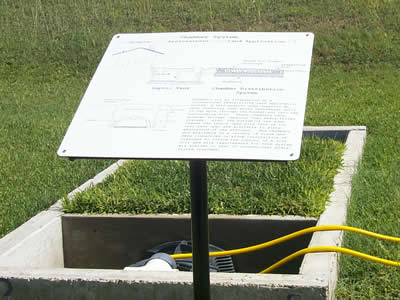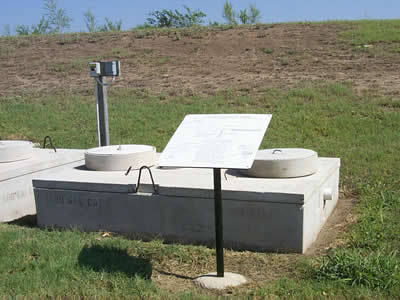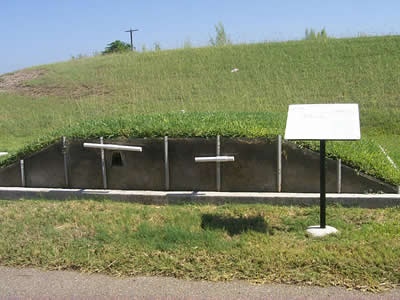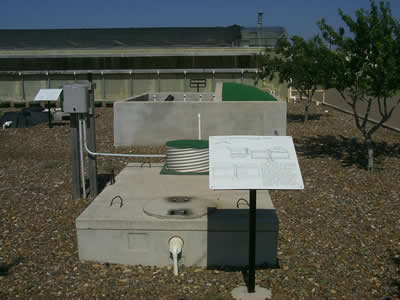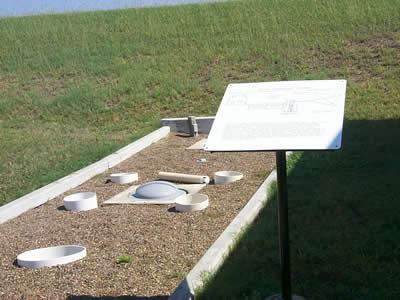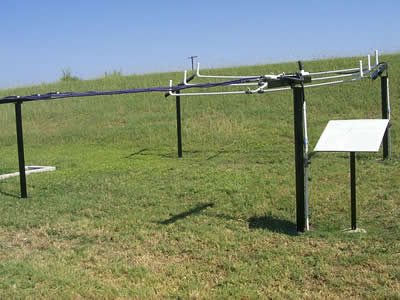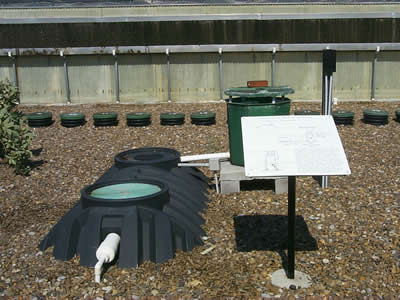The On-Site Wastewater Treatment Training Center was established in 1997 to provide an educational mechanism for training of inspectors, installers, site evaluators, home owners, elected officials, and other people involved in the on-site wastewater treatment industry.
Texas Cooperative Extension, Texas On-Site Wastewater Association, Texas Engineering Extension Service, Texas Agricultural Experiment Station, Texas Natural Resource Conservation Commission, local installers and businesses, Texas On-Site Wastewater Treatment Research Council, and Hidalgo County Health Department played vital roles in the planning and construction of the South Texas International On-Site Wastewater Treatment Training Center in Weslaco. This Training Center could have not been constructed without the help of all the collaborators.
_______________________________
BEGIN TOUR:
Aerobic Treatment System
The aerobic treatment process contains four main components:
- A pretreatment tank, generally referred to as the septic tank. This stage removes materials that microbes cannot degrade.
- An aeration chamber. Treatment in the aeration chamber is a biological process. The air supplied by the air pump allows microbes to thrive. The microbes consume the waste, transforming it into cell mass, non-degradable material, and gases. The chamber contains an aeration system including an air pump, piping, and diffusers to force air in and mix the cell mass with the effluent.
- A settling chamber, commonly called a “clarifier.” This allows the cell mass, which treats the water in the aeration chamber, to settle out. This clarifier also includes a method for returning the bacteria to the aeration chamber.
- The land application system distributes the treated water into the soil. Aerobic treatment units remove a large percentage of the organic matter and suspended solids from the wastewater.
_______________________________
Constructed Wetland System
This system consists of a septic tank, constructed wetland, and land application system. The wetland consists of a bed of graded stone with water flowing just below the surface. Vegetation that is adapted to saturated conditions is grown in this bed, feeding on the nutrients, organic matter, suspended solids, and pathogens in the effluent.
The bed is set in a watertight basin lined with compacted native clay, bentonite clay, concrete, PVC, or a similar watertight substance. Although both hard- and soft-tissue plants can be used in the system, some experts prefer hard-tissue plants believing they provide a pathway for oxygen to enter the wetland during winter months and hard-tissue plants reduce maintenance. However, many homeowners prefer colorful, flowering, soft-tissue plants.
_______________________________
Conventional Land Application System
The conventional land application system consists of a soil treatment area with perforated pipes surrounded by distribution media such as gravel. Effluent passes into the media and is stored there until it can be absorbed into the soil. The microbes, decomposing the waste, form a biological mat (biomat) in the trench at the interface of the soil and the media.
The biomat tends to slow down water movement into the soil creating unsaturated flow, thereby avoiding soil saturation. Microbes in the soil and biomat feed on the waste, nutrients, and pathogens remaining in the wastewater. Water leaves the system by evaporation, transpirtation, and absorption.
_______________________________
Conventional Septic Tank
A septic tank is an enclosed watertight container consisting of one or two compartments. It collects wastewater and provides primary treatment by allowing solids to separate from the water. At the same time solids are settling to the bottom of the tank (sludge), fats, oils and greases rise to the top (scum).
Water should remain in the tank for at least 24 to 36 hours to provide time for solids to settle. Solids are partially decomposed in the tank. Scum and sludge are retained in the tank and must be removed periodically through maintenance. Much of the organic matter, solids, nutrients, and pathogens remain in the effluent as it leaves the septic tank.
_______________________________
Evapotranspiration Bed System
Evapotransporation (ET) beds rely on the combined natural properties evaporation of water from the soil and transpiration by plants growing on top of the bed. An ET bed is a bed of sand with trenches in the bottom for storing the water until it is evaporated or transpired by the plants.
These systems are designed based on rainfall rates and expected evapotransporation rates. These beds can be either lined or unlined, depending on the permeability of the surrounding soil.
Gravely sands and karst soils require a liner which is made of natural clays, synthetic lining, or concrete. Unlined beds are used for impermeable soils like clay. Plant cover is essential to the proper function of these systems. Grasses and other plants must be well maintained for them to work properly.
___________________________
Gravel-less Pipe System
Gravelless pipe is an option for a conventional media-filled land application system. In this system, an 8- to 10-inch corrugated polyethylene pipe is wrapped with a geotextile fabric and buried in soil.
The fabric acts as a biomat interface and a wick, evenly distributing wastewater around the circumference of the pipe. It also works to prevent backfill from entering the discharge holes on the pipe.
The chief advantage to this type of system is that the pipe is flexible and lightweight. It may be placed in curved trenches fitting a specific elevation on a sloping site. However, it requires proper sizing and control of effluent quality (i.e., no scum or solids) to prevent excessive build-up of biomat on the geotextile fabric wrap.
_______________________________
Chamber System
Chambers are an alternative to a conventional media-filled land application system. A hard plastic dome supports an open reservoir that holds wastewater until it can move through the biomat and into the surrounding soil.
These chambers have greater storage capacity than media-filled systems. Also, the bottom of the dome leaves the trench open with 100% of its soil base open and available to allow absorption of the effluent. The chambers are available in a variety of sizes and have connectors to allow construction of trenches to follow the contour of a site. Soil and site requirements for this system are similar to that of conventional media-filled trenches.
_______________________________
Low-Pressure Dosing System
A low-pressure dosing system requires a pump tank and a network of small-diameter pipes (1 to 2 inches) placed in trenches. The pump tank stores the effluent, and the pump intermittently doses it to the pressurized distribution network.
This pressurized system provides a relatively uniform distribution of the wastewater across the land application system. The trenches can be media-filled or constructed with chambers or other products. The trenches serve the purpose of temporarily storing the water until it can be absorbed by the soil.
_____________________________
Mound System
The mound system is ideal for areas with minimal soil between the surface and limiting condition(s) such as groundwater or bedrock. A soil treatment area is created above the natural soil surface to allow for final treatment of wastewater.
The mound has several layers including: permeable fill material (clean sand to a depth greater than 12 inches), a pressure distribution system, a cap, and topsoil. In essence, this is a traditional low-pressure dosing system built above ground level. Its layers work in combination with the native soil to treat the wastewater. Like its traditional counterparts, it relies on the soil microbes to provide the natural treatment process.
______________________________
Single-Pass Sand Filter System
A typical single-pass sand filter system consists of a septic tank, dosing tank, sand filter (which is a lined watertight box filled with specific sand materials), and the land application system.
The sand filter container can be constructed of concrete or an excavation lined with a watertight liner. Sand filters function as a single-pass system dosing septic tank effluent intermittently to the sand bed before entering the land application system.
Sand filters generally have 24 to 36 inches of sand for treatment of the wastewater. The bed is underlain with a bed of graded gravel and a collection system. Sand filters can either be open to the surface, called free access, or buried below ground, as shown here.
_______________________________
Spray Dispersal System
A spray dispersal system distributes the treated effluent on top of the soil surface. The effluent must be disinfected and meet secondary treatment standards. A spray system consists of a pump chamber and spray field.
The spray field is constructed similarly to a lawn irrigation system. The area must have vegetation and be landscaped to minimize runoff and have adequate setbacks. Sprinkler heads should be low trajectory to minimize aerosol production. The application rate will vary with climatic conditions and soil type. Effluent applied to the land surface undergoes evaporation, transpiration by plants, and absorption into the soil.
_______________________________
Subsurface Drip Dispersal System
A subsurface drip dispersal system consists of a pretreatment system, a pump tank, filtration system, subsurface drip tubing, and controller. The pump tank stores the effluent until the controller turns on the pump to dose water into the soil. The filtration system removes the large solids from the effluent and flushes the solids back to the pretreatment device.
The drip tubing is placed directly into the soil without the use of media-filled trenches. The system relies on drip tubing with emitters to reduce the water pressure before the effluent enters the soil. Since the emitters in the line have the same emission rate, wastewater is uniformly applied to the dispersal field.
The drip tubing is placed approximately 2 ft apart in the landscape so the emitters are on a grid pattern within the existing landscape. The drip lines are buried relatively shallowly so the soil can provide treatment, the landscape plants can use the nutrients and water, and the system can maximize evaporation.
____________________________
Recirculating Media Filter System
A recirculating media filter is a method of pretreatment that provides aerobic treatment of wastewater. The wastewater is generally pumped from a pump/recirculation tank, dispersed over a media bed, and allowed to drain back into the tank.
The wastewater is aerated as it flows over the media. The media is constructed from a variety of plastics, textile, stone, or redwood laths into a number of shapes (honeycomb blocks, rings, cylinders, etc.). A biological film grown on the media feeds on the contaminants contained in the wastewater. As the film establishes and grows, it will exceed the ability to hold onto the media. The biological materials slough off and return to the pump/recirculating tank with the wastewater for further decomposition.
END TOUR.

